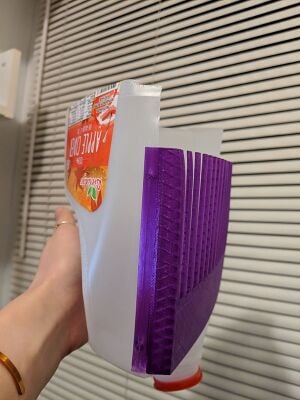
Wild Berry Scoop Picker[edit | edit source]
Project developed by User:Sswade
Abstract[edit | edit source]
- Berry pickers are useful for picking lots of berries at once instead of having to pick each berry by hand. When designing this picker the goal was to use the least amount of materials possible and also use materials that are easy to find. This berry picker is designed to fit onto gallon-sized milk jugs. The milk jug is used as the receptacle for the berries and as the handle. The 3d printed comb fits on and attaches with 3d printed pegs or any 3mm cylindrical object you have laying around.
- Picture of completed print using your printer
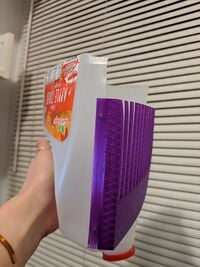
Bill of Materials[edit | edit source]
- 1 x Milk Jug (one gallon)
- 1 x printed comb
- 4 x 3mm pegs (3D Printed or just things that will fit in the holes)
Tools needed[edit | edit source]
- MOST Delta RepRap or similar RepRap 3-D printer
- Scissors (or knife of some sort)
Skills and knowledge needed[edit | edit source]
- None other than 3D printing knowledge
Technical Specifications and Assembly Instructions[edit | edit source]
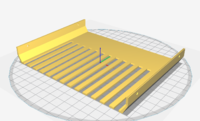
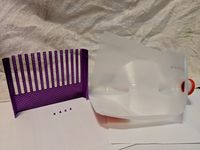
- Cut the bottom of the milk jug off
- Cut two slits up the flatter corners of the milk jug on either side of the handle up to where the bottle starts to bend to the top
- Cut along the part where it starts to bed to cut off the side of the milk jug. This will be where the comb attaches to the milk jug
- Print the main comb as shown:
- I recommend printing at least 2 lines for the wall and at least 20% infill
- My printer has a nozzle size of 0.4mm so a wall thickness of at least 0.8mm
- With layer height = 0.2mm, line width = 0.4mm, infill = 20%, at 60mm/s the estimated print time is 2 hours 30 minutes and uses 28g of plastic
- Print 4 pegs (or find 4 pegs)
- Fit the milk jug into the slit in the comb, secure one side at a time with the pegs, tucking and trimming the excess "top" part of the jug to make the "back" part of the scoop catcher
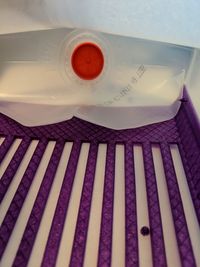
Common Problems and Solutions[edit | edit source]
- Sometimes the back part doesn't want to fold in to create the back nicely, you can cut along the seam of the jug more to give yourself more leeway in folding it
- It helps to pre-poke the milk jug with something sharp to make a starter hole before inserting the pegs first (I used a pen)
Cost savings[edit | edit source]
- 28g of PLA ($0.42 USD) + recycled milk jug (free)
- Compared to a Comercial Berry Picker from Amazon
- Cost savings of 16.55 (97.5% cost savings)
Benefited Internet Communities[edit | edit source]
- Name and add links to at least 5 using single brackets around [url name]
References[edit | edit source]
- The sources of information (e.g. engineering handbooks, journal articles, government documents, webpages, books, magazine articles etc.). References should use the and <references /> tags and can be in any format but should include all the information necessary for someone else to find the same information you did. For example:[1]
- ↑ web page: Department of Energy (DOE) Landscaping and Energy Efficiency, DOE/GO-10095 (1995) Available: http://web.archive.org/web/20021201231338/http://www.eren.doe.gov:80/erec/factsheets/landscape.html
<nowiki> Based on the developmental needs addressed (e.g. food, heat, electricity, clean water, health care, etc.) be sure to label your device in the proper categories e.g. use . Be sure to categorize your device so that it will be easy to find – for example “Low voltage connection basics” is categorized in